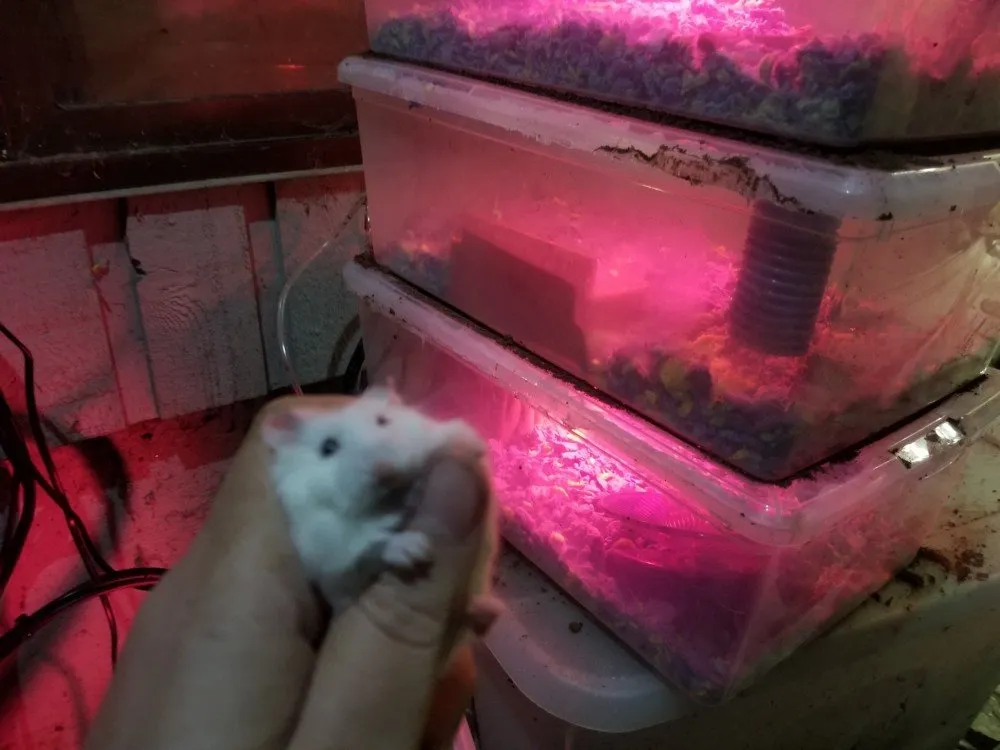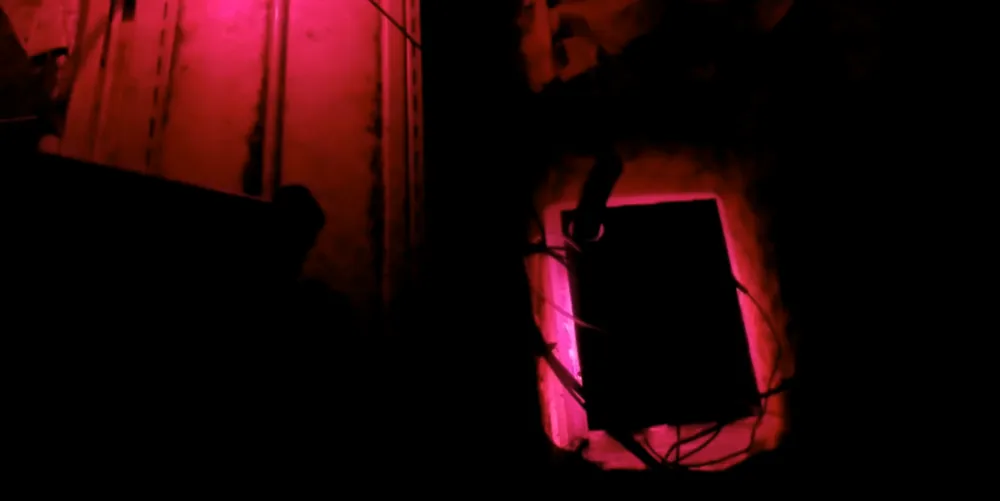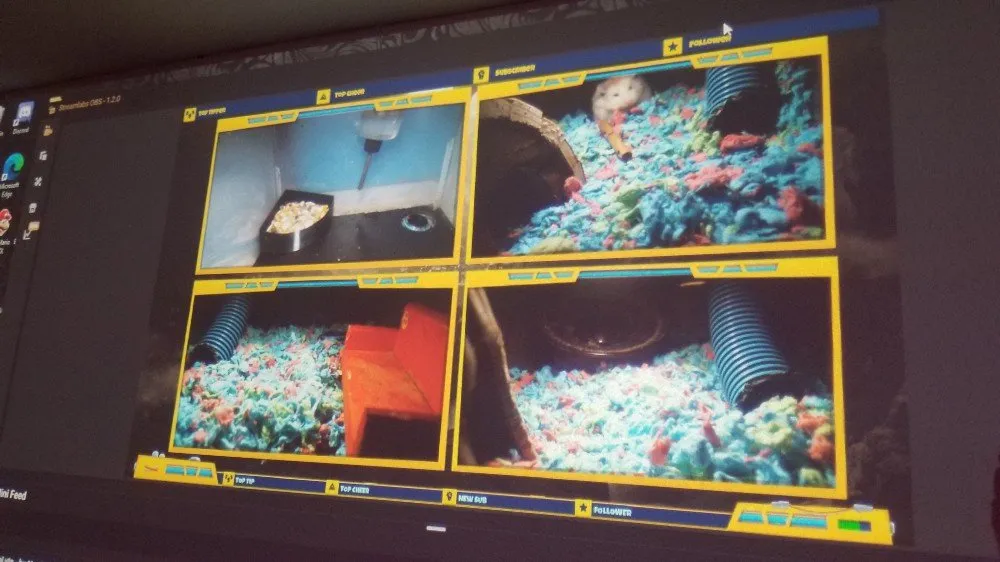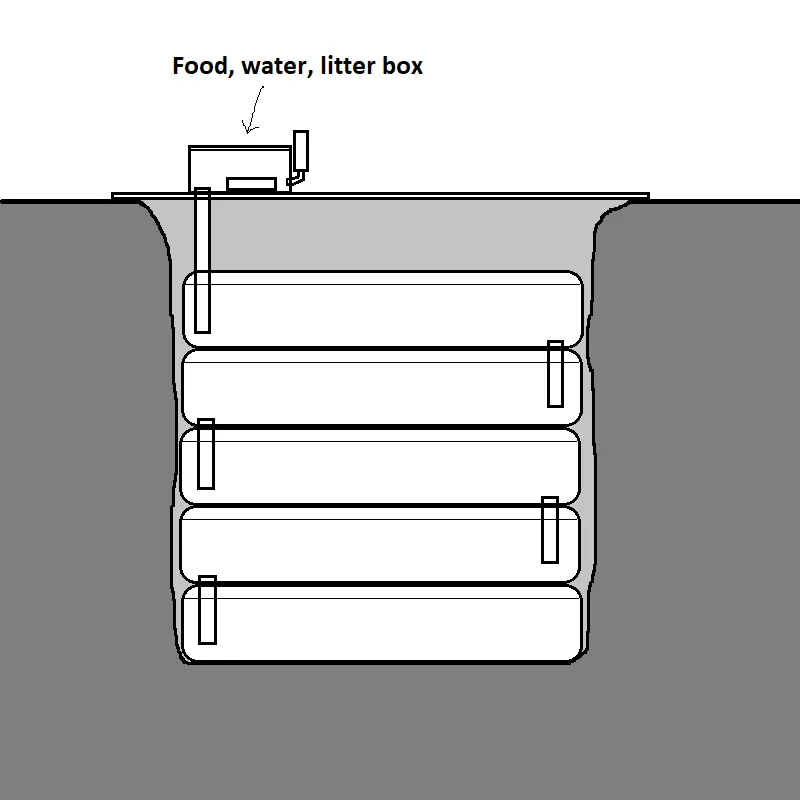
Probably this won’t surprise you that much, if you’ve already seen my underwater hamster habitat articles. Constructing scale model hostile environment living spaces is a hobby of mine, bringing the privilege and safety of high technology normally reserved for human use down within reach of our smaller, hairier cousins like some sort of animal loving Prometheus.
I did this for much the same reason I built the underwater version: To learn what problems commonly befall buried structures and how to design in such a way as to mitigate or prevent them before they happen. This doesn’t mean I’m content for my pet hamsters to take risks in my place; as with the underwater habs, the bunker also underwent prolonged safety testing before use.
You may have noticed the pink glow. That’s from red film placed over the LED light fixtures inside. Hamsters are crepuscular, they prefer red shifted light if any. A study on rats confirmed the same thing, that for nocturnal or crepuscular animals, red shifted light is the gentlest on their eyes.

The red lighting doesn’t show up on webcam because many modern webcams automatically color correct in software. I’ve not yet been able to figure out how to disable the feature, but then leaving it on gives a more chromatically balanced, pleasant to look at view. Above, you can see the layout of the bunker.
Not all of it is underground, just about 75% of it is. It’s not just one contiguous building extending into the Earth, it’s separated into the three story subterranean portion and the above ground building, which must be exposed for ease of replenishing food, water and cleaning out a small litterbox.
There’s an exercise wheel, three hides (the hollow base of the wheel doubles as a hide), a wooden couch to gnaw on, additional chew toys, climbing tubes to move between floors, and an aquarium air pump on the surface with in-line filter that constantly sends fresh, clean air down to the lowest level of the bunker.

Digging the hole was burdensome as it’s under the deck behind the house. I couldn’t fully stand up and had to dig with a half length shovel while hunched over. It was more physically stressful and took longer than it really needed to, but the end result was worth it. Above you can see the subterranean portion of the bunker assembly lowered into the freshly dug hole.
There’s a moisture guard on top of it to stop rain water from seeping in through holes in the roof, drilled so I could zip tie the lighting fixtures and webcams into place.
I’d estimate the climbing tube between the surface building and sublevel 1 to be about a foot long, which means the floor of the surface building is perhaps six or seven inches from the ceiling of the subterranean section.

Here’s the surface building prior to the addition of the red film over the lights. The layout has changed somewhat since the time this photo was taken. A larger 3D printed food dish was added, the litterbox was shifted off camera to make room for it and the wiring was changed up a bit to solve a USB overloading issue.
Basically the USB ports on the PC which streams the view from the Hambunker webcams live, 24/7 started to die out. Not wanting to replace the motherboard I bought some powered USB hubs that come with a wall adapter to make up for the current shortfall from the computer. This required separately powering the lights and webcams, so now there are 2 umbilicals, but it all works at this point.
I’ve had some amount of trouble with rats trying to get inside hambunker. None have yet succeeded but I spot them on the live feed sometimes. To them it must be a tempting target, especially in winter, as it’s electrically heated and full of food. I spray around the surface periodically with mint solution, which does a shockingly good job of repelling rats.

Here’s the view on the projector from “mission control” where I monitor both Hambunker and Hampture (the underwater base from prior articles) around the clock. At some point you may have asked “what’s the point of this, when hamsters in nature live in burrows anyway?”
Indeed they do. But those burrows typically aren’t so safe or clean. Nor do they have webcams in every chamber so we can enjoy watching them. It’s something like the same enjoyment one gets from spectating an ant farm, just with occupants I’d argue are cuter than ants, and actually underground in this case.
One of the lessons I learned so far is that building anything that’s exposed to the elements all the time has it’s own challenges versus, for example, an underwater habitat. Certainly building for the underwater environment is difficult in its own right, believe me I know, but it’s also relatively stable. The problem with the outdoor surface environment is that it’s always changing.

Seasonal changes in temperature and humidity, along with the temperature changes during the day/night cycle, mainly. But also the constant activity of living things. Rats were a problem until I hit on mint spray (and electric traps) but so were flying insects who would routinely find their way inside Hambunker through the air holes of the surface building.
My solution for a while was to let spiders set up webs, which would catch the flying insects (flies, moths, mosquitos). The natural approach. But there’s only so much room inside that container, really only one spider can set up shop there, and he’s only so hungry.
So I set up a bug zapper adjacent to the surface building, running off the same extension cord. It’s under the deck and an additional rain barrier, no problems with it so far. Probably the service life won’t be as good as it would be if used indoors, but it’s doing an awesome job of keeping Hambunker insect free.

What’s the next step? If there’s fan demand for it, a larger version of the same thing. Bigger floors and more of them, using the wide, long, shallow rubbermaid storage bins intended for tucking under your bed. I may need to rent an excavator for this but I also may just bust my ass with a shovel again, as yet it’s undecided.
This hypothetical Fallout style vault would house between 10 and 12 hamsters. All the same gender so as to avoid a behavioral sink / mouse universe outcome. Spectating their interactions should be more interesting than the current Hambunker, which is home to only one occupant currently.
Hamsters are asocial, and territorial. They can do well if they’re same gendered siblings, but only in enclosures where there’s sufficient space for every individual to have their own hideout. If they can’t have private territory or it’s not defensible because there’s too little room, they become stressed and violent.
They’re not naked mole rats after all, who invented the idea of subterranean rodent colonies long before I did. At the end of the day I’m aware this is a pretty weird hobby, re-creating what nature already perfected. But I learn a great deal and exercise both my brain and body in the course of solving the many problems facing such a project.
Besides, the way things are looking now, we all might need a bunker sooner or later. At least this way, even if humans are wiped out, rodents will once again dodge extinction like they did back when dinosaurs were at the top of the food chain.
As before, the Patreon, Twitch live stream of Hambunker, Youtube channel, merchandise and more can be found here.
